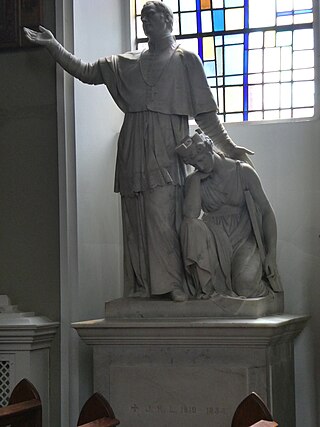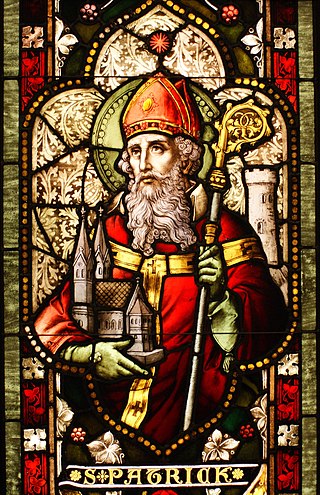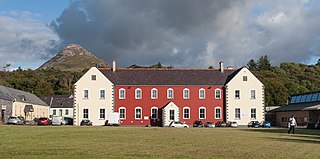
Achill Island is the largest of the Irish isles and lies off the west coast of Ireland in County Mayo. It has a population of 2,345. Its area is 148 km2 (57 sq mi). Achill is attached to the mainland by Michael Davitt Bridge, between the villages of Achill Sound and Polranny. A bridge was first completed here in 1887. Other centres of population include the villages of Keel, Dooagh, Dooega, Dooniver, and Dugort. The parish's main Gaelic football pitch and secondary school are on the mainland at Polranny. Early human settlements are believed to have been established on Achill around 3000 BC. The island is 87% peat bog. The parish of Achill consists of Achill Island, Achillbeg, Inishbiggle and the Corraun Peninsula.

The Great Famine, also known within Ireland as the Great Hunger or simply the Famine and outside Ireland as the Irish Potato Famine, was a period of starvation and disease in Ireland lasting from 1845 to 1852 that constituted a historical social crisis which subsequently had a major impact on Irish society and history as a whole. The most severely affected areas were in the western and southern parts of Ireland--where the Irish language was dominant--and hence the period was contemporaneously known in Irish as an Drochshaol, which literally translates to "the bad life" and loosely translates to "the hard times". The worst year of the famine was 1847, which became known as "Black '47". During the Great Hunger, roughly 1 million people died and more than 1 million more fled the country, causing the country's population to fall by 20–25% between 1841 and 1871. Between 1845 and 1855, at least 2.1 million people left Ireland, primarily on packet ships but also on steamboats and barques—one of the greatest exoduses from a single island in history.
Bohermeen is a Roman Catholic parish in the Irish Diocese of Meath. Its English name is a corruption of an ancient Irish language name, An Bóthar Mín, which meant the smooth road. Originally one of the five famed ancient roadways that led from the mediaeval capital of Ireland, Tara, approximately 10 miles away cut through the area. The quality of the roadway, in an era of dirt-roads, earned for it the nickname of the smooth road, An Bóthar Mín.
The Irish Church Missions (ICM) is a conservative and semi-autonomous Anglican mission. It was founded in 1849 as The Irish Church Missions to the Roman Catholics chiefly by English Anglicans though with the backing and support of Church of Ireland clergy and bishops, with the aim of converting the Roman Catholics of Ireland to Protestantism. The reference to Roman Catholics in the title was removed in 2001.

The Protestant Ascendancy, also known simply as the Ascendancy, was the political, economic, and social domination of Ireland between the 17th century and the early 20th century by a minority of landowners, Protestant clergy, and members of the professions, all members of the Established Church. The Ascendancy excluded other groups from politics and the elite, most numerous among them Roman Catholics but also members of the Presbyterian and other Protestant denominations, along with non-Christians such as Jews, until the Reform Acts (1832–1928).

John MacHale was the Irish Roman Catholic Archbishop of Tuam, and Irish nationalist.

Operation Shamrock was a scheme bringing refugee children from mainland Europe to Ireland in the aftermath of the Second World War. It was organised by the Irish Red Cross, and involved about 500 children, mostly from Germany, who stayed for three years before returning home.

Ireland during the period of 1536–1691 saw the first full conquest of the island by England and its colonization with mostly Protestant settlers from Great Britain. This would eventually establish two central themes in future Irish history: subordination of the country to London-based governments and sectarian animosity between Catholics and Protestants. The period saw Irish society outside of the Pale transform from a locally driven, intertribal, clan-based Gaelic structure to a centralised, monarchical, state-governed society, similar to those found elsewhere in Europe. The period is bounded by the dates 1536, when King Henry VIII deposed the FitzGerald dynasty as Lords Deputies of Ireland, and 1691, when the Catholic Jacobites surrendered at Limerick, thus confirming Protestant dominance in Ireland. This is sometimes called the early modern period.

The Rt Hon. Henry Maxwell, 7th Baron Farnham, K.P., was an Irish peer, a Member of Parliament, an evangelical Orangeman and County Cavan landowner. During the hunger years of late 1820s and late 1840s, he was much reviled for evicting tenants and for offering relief only on condition of conversion to Protestantism.

James Warren Doyle, OESA (1786–1834) was a Roman Catholic Bishop of Kildare and Leighlin in Ireland, who used the signature "JKL", an acronym from "James Kildare and Leighlin." Doyle was active in the Anti-Tithe movement. A campaigner for Catholic Emancipation until it was attained in 1829, he was also an educator, church organiser and the builder of Carlow cathedral.
Mark Francis Ryan, was an Irish revolutionary, a leading Member of the Irish Republican Brotherhood and author.
The Reverend Henry Maxwell, 6th Baron Farnham was an Irish peer and Church of Ireland clergyman who reputedly used his prerogatives as landlord to induce his distressed tenants to abandon their Catholic faith and take the Anglican communion.
The Second Reformation was an evangelical campaign from the 1820s onwards, organised by theological conservatives in the Church of Ireland and Church of England.

Christianity is, and has been the largest religion in Ireland since the 5th century. After a pagan past of Antiquity, missionaries, most famously including Saint Patrick, converted the Irish tribes to Christianity in quick order, producing a great number of saints in the Early Middle Ages, and a faith interwoven with Irish identity for centuries since − though less so in recent times.

Industrial schools were established in Ireland under the Industrial Schools (Ireland) Act 1868 to care for "neglected, orphaned and abandoned children". By 1884, there were 5,049 children in such institutions throughout the country. The Act was superseded by the Children Act 1908.
Achill Missionary Herald and Western Witness (1837-1869) was an Irish Provincial Newspaper.

Dugort, sometimes spelled Doogort, is a historical village on Achill Island in County Mayo, Ireland. It is next to Slievemore mountain. There are two blue flag beaches in Dugort: Silver Strand which is located at the foot of the Slievemore Mountain and the Golden Strand which is located further east.
Margaret Louisa Aylward (1810-1889) was an Irish Catholic nun, philanthropist, and founder of the Sisters of the Holy Faith.

Edward Nangle was a Church of Ireland minister and the founder of the Achill Mission Colony. He established a Protestant mission on Achill Island, County Mayo, in 1834 and worked there for eighteen years with the aim of bringing Protestantism to the Native Irish Christians who were impoverished in large part due to the Penal Law policies of the Protestant Ascendancy. Edward Nangle was involved in evangelical attempts to convert Catholics to Protestantism. He opened a Christian school on the island where children were taught reading, writing, agricultural skills and Christianity as part of a Missionary Colony. His presence on the island led to some press coverage and parliamentary debates. The island itself was developed with a pier built at Dugort, a courthouse at Achill Sound and a road network between numerous key locations on the island. A plaque hanging in St. Thomas Church, Dugort, dedicated to Edward Nangle and erected by friends after his death, reads: "He devoted his life from the year 1834 to the welfare of the people of Achill among whom he lived for many years."
Bridget Patricia Byrne is an Irish writer of narrative nonfiction. Two of her books deal with historical events in nineteenth-century Achill Island.














